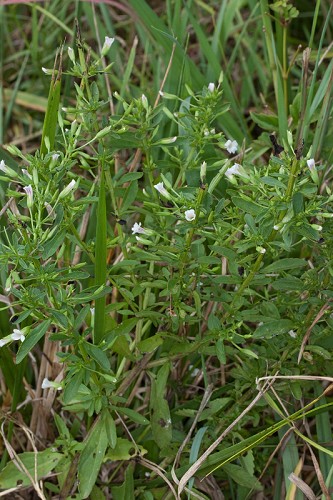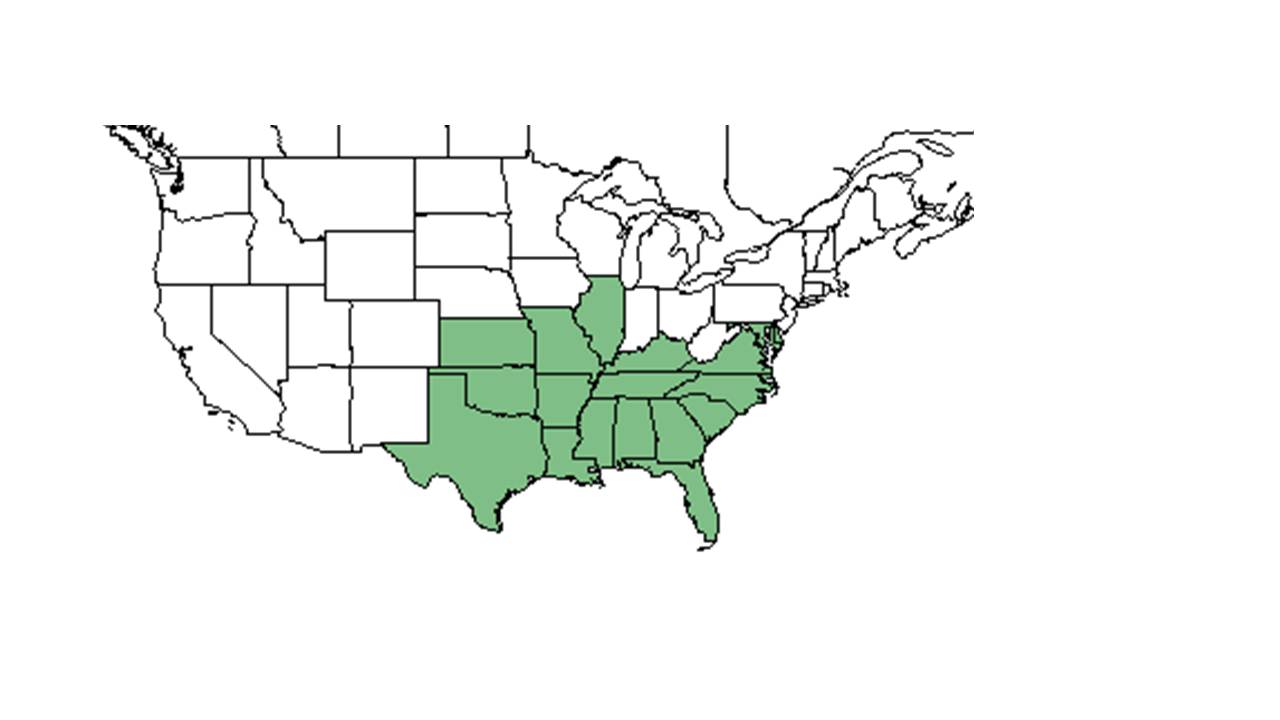Difference between revisions of "Mecardonia acuminata"
Emmazeitler (talk | contribs) |
|||
| Line 48: | Line 48: | ||
<!--===Diseases and parasites===--> | <!--===Diseases and parasites===--> | ||
| − | ==Conservation and | + | ==Conservation, cultivation, and restoration== |
| − | == | + | ==Cultural use== |
==Photo Gallery== | ==Photo Gallery== | ||
<gallery widths=180px> | <gallery widths=180px> | ||
Revision as of 17:29, 8 June 2021
| Mecardonia acuminata | |
|---|---|

| |
| Photo by John R. Gwaltney, Southeastern Flora.com | |
| Scientific classification | |
| Kingdom: | Plantae |
| Division: | Magnoliophyta - Flowering plants |
| Class: | Magnoliopsida – Dicotyledons |
| Order: | Scrophulariales |
| Family: | Scrophulariaceae |
| Genus: | Mecardonia |
| Species: | M. acuminata |
| Binomial name | |
| Mecardonia acuminata (Walter) Small | |

| |
| Natural range of Mecardonia acuminata from USDA NRCS Plants Database. | |
Common name: Axilflower[1]
Contents
Taxonomic notes
Synonyms: Bacopa acuminata (Walter) B.L. Robinson; Pagesia acuminata (Walter) Pennell ssp. typica; Mecardonia acuminata ssp. acuminata.[1]
Varieties: Mecardonia acuminata (Walter) Small var. acuminata; Mecardonia acuminata (Walter) Small var. microphylla (Rafinesque) Pennell; Mecardonia acuminata (Walter) Small var. peninsularis Pennell.[1]
Description
It has been observed to be both frequent and infrequent where it is found.[2]
"Erect, branched, glabrous perennial, the stems angled, 1-5 dm tall, usually blackening on drying. Leaves opposite, firm, oblanceolate to elliptic, mostly 1-4.5 cm long, 5-12 mm wide, distally serrate, sessile or narrowly cuneate to a short, obscure petiole. Peduncles axillary, solitary, about as long, or longer than the subtending leaf, with 2 linear bractlets at the base; sepals 5, linear-lanceolate, 7-9 mm long; corolla white or tinged with lavender, personate, 9-11 mm long; fertile anthers 4, normal. Capsule ellipsoid, 6-8 mm long."[3]
Var. microphylla is distinguished by its peduncles, which are smaller than 10 mm and its sepals, which are wider than 2 mm. Both var. peninsularis and var. acuminata exhibit the reverse of this. Var. peninsularis has main stem leaves that are 1.2-2 cm long, outer sepals that are 5-6 mm long, a corolla that is 7-9 mm long, a strongly branched base, and widely-spread branches. On the other hand, var. acuminata has main stem leaves that are 3-4.5 cm long, outer sepals that are 6-8 mm long, a corolla that is 9-10 mm long, branching that begins above the base, and a usually erect growth.[1]
Distribution
Var. acuminata ranges from Deleware and Maryland, south to north peninsular Florida, west to east Texas, and north to Kentucky, Tennessee, and Missouri. Var. microphylla ranges from southcentral Georgia to the Florida Panhandle and west to eastern Louisiana.[1] Var. peninsularis ranges from the northern Florida peninsula, south to southern Florida.[1]
Ecology
Habitat
This species has been found along grassy limestone glades in open areas, in floodplain forests, and savannas.[2] It also can be found in human distrubed areas such as parking areas, powerline corridors, and roadside ditches.[2] This species grows in semi-shaded environments wet, limestone, and sandy loam soils.[2] Var. acuminata and var. peninsularis thrive in wetland habitat types, such as marshes, ditches, wet pine savannas, bottomland forests, wet disturbed areas. Var. microphylla is limited to the margins of Coastal Plain ponds and wet pine savannas.[1] In Louisiana, soils are of the upland coastal plain type with little slope and low fertility.[4] Associated species include Sporobolus vaginiflorus, Stenaria nigricans, Polygala grandiflora var. angustifolia, Rhynchospora, Fuirena, and Scleria.[2]
Phenology
M. acuminata flowers from July through September and fruits from August through October.[1]
Seed dispersal
This species is thought to be dispersed by gravity.[5]
Conservation, cultivation, and restoration
Cultural use
Photo Gallery
References and notes
- ↑ 1.0 1.1 1.2 1.3 1.4 1.5 1.6 1.7 Weakley, A.S. 2015. Flora of the southern and mid-atlantic states. Working Draft of 21 May 2015. University of North Carolina at Chapel Hill, Chapel Hill, North Carolina.
- ↑ 2.0 2.1 2.2 2.3 2.4 Florida State University Robert K. Godfrey Herbarium database. URL: http://herbarium.bio.fsu.edu. Last accessed: June 2014. Collectors: Loran C. Anderson, Ann F. Johnson, Wilson Baker, Robert K. Godfrey, R.A. Norris, R. Komarek, and Lisa Keppner. States and Counties: Florida: Calhoun, Gadsden, Jackson, Jefferson, Leon, Suwannee, Taylor, and Washington. Georgia: Grady.
- ↑ Radford, Albert E., Harry E. Ahles, and C. Ritchie Bell. Manual of the Vascular Flora of the Carolinas. 1964, 1968. The University of North Carolina Press. 938. Print.
- ↑ Thill, R. E. (1983). Deer and cattle forage selection on Louisiana pine-hardwood sites. New Orleans, LA, USDA Forest Service.
- ↑ Kirkman, L. Katherine. Unpublished database of seed dispersal mode of plants found in Coastal Plain longleaf pine-grasslands of the Jones Ecological Research Center, Georgia.